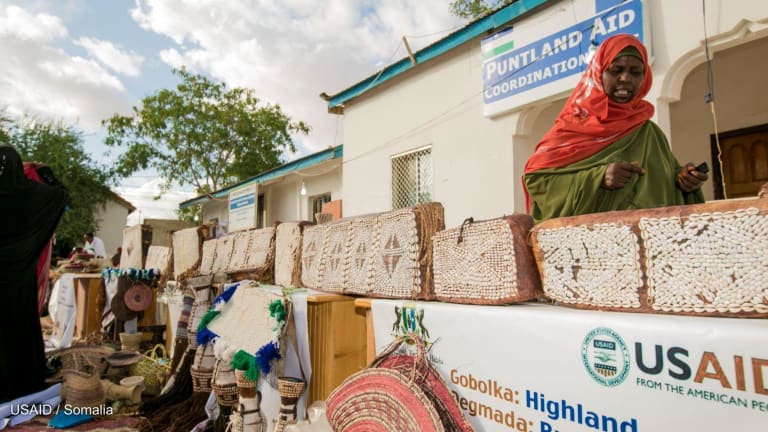Which countries spend the least on their own development?
With ODA levels dropping after a period of record highs, how will governments respond? Can they turn to their income as a means for development? Devex analyzed the numbers to see which countries spend the least on their development.
For countries that have historically depended on aid, the coming years look likely to be increasingly difficult. Last year, official development assistance, or ODA, levels dropped significantly after five years of consistent growth. With major donor countries changing up their strategies, it is feared that ODA levels will drop even more within the next few years. Countries will increasingly be left to fend for themselves to adjust to the uncertain climate, but which countries are least prepared to do so? We look at which countries currently spend the least on their own development. This analysis assesses the capacity of a country to fund its development based on its recorded government expenditure in relation to its gross national income using the World Bank’s dataset on government final consumption expenditure. The World Bank defines this dataset as the figures the local government spent on purchasing goods and services as well as on national defense and security. Data was extracted through the World Bank’s Open Data portal. This is far from a perfect measure. Not all government expenditure is development-related. And government expenditure is not the sole measure of a country’s capability to adapt to ODA changes; political, institutional, and economic factors should be taken into consideration. However, it at least provides an indication of where issues may lie. How does spending compare to income? At a global scale, the data indicates world GNI in 2023 sat at $106.3 trillion, but only $17.5 trillion — or 16.5% — was collectively spent by governments. At a regional level, and excluding high-income countries, the East Asia and Pacific region as a whole has the highest recorded GNI of $22.3 trillion, but only 14.9%, or $3.3 trillion, of it is spent by the government on development. This is followed by the Latin America and Caribbean region with a $5.4 trillion collective GNI, and $935.8 billion government spending on development — just 17.3% of the GNI. Countries with the lowest government expenditure to GNI ratio Chad Chad has a GNI of almost $13 billion, but it only spent $553.5 million on its development, which accounted for 4.3% of its GNI in 2023. Sierra Leone Sierra Leone has a GNI of $7.3 billion and spent only $352.9 million on its development, which is only 4.8% of its GNI in 2023. Bangladesh Bangladesh has the largest GNI among those in the list, with $493.9 billion, but it only spent $24.8 billion on its development, which accounts for only 5% of its GNI in 2023. Ghana Ghana has a GNI of $79.8 billion, but only spent 5.6% — or $4.5 billion — on its development in 2023. Angola Similar to Ghana, Angola only spent 5.6% — around $4.4 billion –– of its GNI of $78 billion in 2023 on its development. <div class='tableauPlaceholder' id='viz1747219103650' style='position: relative'><noscript><a href='#'><img alt='Dashboard 1 ' src='https://public.tableau.com/static/images/Go/GovtexpenditurevsGNI/Dashboard1/1_rss.png' style='border: none' /></a></noscript><object class='tableauViz' style='display:none;'><param name='host_url' value='https%3A%2F%2Fpublic.tableau.com%2F' /> <param name='embed_code_version' value='3' /> <param name='site_root' value='' /><param name='name' value='GovtexpenditurevsGNI/Dashboard1' /><param name='tabs' value='no' /><param name='toolbar' value='yes' /><param name='static_image' value='https://public.tableau.com/static/images/Go/GovtexpenditurevsGNI/Dashboard1/1.png' /> <param name='animate_transition' value='yes' /><param name='display_static_image' value='yes' /><param name='display_spinner' value='yes' /><param name='display_overlay' value='yes' /><param name='display_count' value='yes' /><param name='language' value='en-US' /></object></div><param name='device' value='desktop' /><param name='showShareOptions' value='false' /> <script type='text/javascript'> var divElement = document.getElementById('viz1747219103650'); var vizElement = divElement.getElementsByTagName('object')[0]; if ( divElement.offsetWidth > 800 ) { vizElement.style.width='590px';vizElement.style.height='617px';} else if ( divElement.offsetWidth > 500 ) { vizElement.style.width='590px';vizElement.style.height='617px';} else { vizElement.style.width='100%';vizElement.style.height='727px';} var scriptElement = document.createElement('script'); scriptElement.src = 'https://public.tableau.com/javascripts/api/viz_v1.js'; vizElement.parentNode.insertBefore(scriptElement, vizElement); </script> <i style=font-style: georgia;”>Map of countries that spend the least on their own development, based on 2023 data</i> Try out Devex Pro Funding today with a free five-day trial, and explore funding opportunities from over 850 sources in addition to our analysis and news content.
For countries that have historically depended on aid, the coming years look likely to be increasingly difficult.
Last year, official development assistance, or ODA, levels dropped significantly after five years of consistent growth. With major donor countries changing up their strategies, it is feared that ODA levels will drop even more within the next few years.
Countries will increasingly be left to fend for themselves to adjust to the uncertain climate, but which countries are least prepared to do so?
This story is forDevex Promembers
Unlock this story now with a 15-day free trial of Devex Pro.
With a Devex Pro subscription you'll get access to deeper analysis and exclusive insights from our reporters and analysts.
Start my free trialRequest a group subscription Printing articles to share with others is a breach of our terms and conditions and copyright policy. Please use the sharing options on the left side of the article. Devex Pro members may share up to 10 articles per month using the Pro share tool ( ).
Alecsondra Si is a Junior Development Analyst at Devex. She analyzes funding data from bilateral and multilateral agencies, foundations, and other public and private donors to produce content for Devex Pro and Pro Funding readers. She has a bachelor’s degree in International Studies - major in European Studies from De La Salle University, Manila, Philippines.




